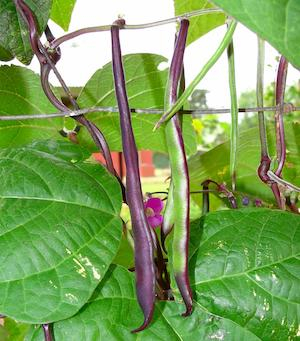
Fresh green beans are always a treat.
July 31, 2023 - Yes, I know it sounds insane to be planting vegetables now, but we produce crops based on the calendar, not on how we feel when doing it. Remember, time and tide wait for no man, so I’m planting pole beans today. Irrigation will be required, of course.
Green beans require warms soils to germinate and can’t tolerate frosts, freezes, or hot temperatures so should be planted no later than August for a fall crop. Green beans pollinate and set pods best when the temperatures are in the 70’s. Since our first frost normally arrives around mid-November, it’s important to have fully established plants full of blooms when cooler temperatures arrive. After the seedlings establish themselves and have their first true leaves, thin the plants to 3-4 inches apart.
Green beans require at least 8 hours of direct sun each day. Beans aren’t picky about soil types but should be planted in areas that drain well. It is ideal to till in several inches of compost or organic matter into the soil if possible and incorporate 2 pounds of a complete garden fertilizer (13-13-13, 10-20-10, etc.) per 100 square foot of bed or every 35 feet of row. The ideal soil pH for growing green beans is 6.0-7.5, so liming is probably in order here.
Green beans are direct-seeded into the garden. Create a raised row about 6 inches high and 8-12 inches wide. Multiple rows should be around 36 inches apart. Open a shallow trench 1-2 inches deep with the corner of a hoe or a stick. Drop the seed several inches apart to insure a good stand. Cover lightly with loose soil using a hoe or garden rake. Make sure the seed isn’t too deep or it won’t germinate.
Check the progress of your green bean plants when they are 6-8 inches tall. If they are vigorous and healthy you don’t need to do a thing. If they are pale green and not vigorous you will need to apply a high nitrogen fertilizer to stimulate their growth. Use 1 cup of ammonium sulfate (21-0-0) for every 35 feet of row. Sprinkle half of the fertilizer down each side of the row. Lightly work it into the soil and then water. This extra fertilizer application to boost the plants along is known as “side-dressing.” Green beans are relatively pest free, however watch for aphids, stinkbugs, spider mites, and rust, and treat with an appropriately labeled pesticide following all label directions.
Greens beans are generally ready to harvest about 56 days from seeding. Green beans should be harvested when the pods are young and tender, 3-5 inches long, and before the seeds inside begin to bulge. It’s better to pick them too small than too large. Harvest them at least every other day so the pods don’t become tough and stringy.
Recommended varieties for Texas include Blue Lake (round), Contender (round), Derby (round), Tendergreen (round), Topcrop (round), Blue Lake-Pole (round), Jade-Pole (round), Kentucky Wonder-Pole (round), Greencrop (flat), Roma II (flat), and Purple Podded Pole (flat). Green beans are native to Central America.
Greg Grant is the Smith County Horticulturist for the Texas A&M AgriLife Extension Service and the author of Texas Fruit and Vegetable Gardening. You can read his “Greg’s Ramblings” blog at arborgate.com or his “In Greg’s Garden” in each issue of Texas Gardener magazine (texasgardener.com). More research-based gardening information from the Texas A&M AgriLife Extension Service can be found at aggie-horticulture.tamu.edu.








